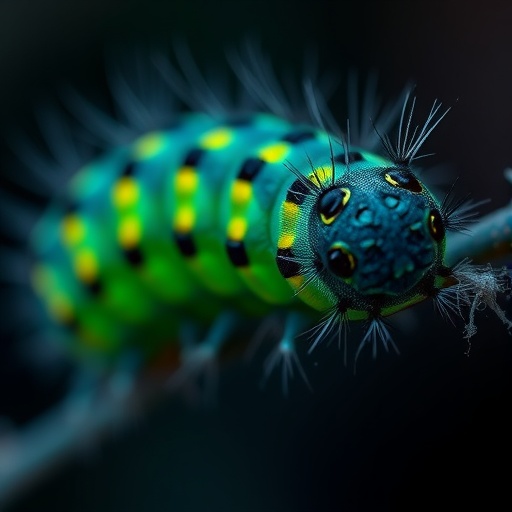In the natural world, the color of an organism can significantly influence its survival and reproductive success. A recent study led by researchers Cisternas, Ríos, and Gianoli unveils the surprising impact of social living on larval melanism within gregarious caterpillars, suggesting that the interactions among these organisms can shape not only their behavior but also their physical traits. This groundbreaking research sheds light on the complex interplay between environmental factors and biological responses, paving the way for a deeper understanding of the evolutionary processes that govern color adaptation.
Caterpillars, the larval stage of moths and butterflies, are renowned for their diverse range of colors and patterns. These traits traditionally serve functions such as camouflage or warning signals to potential predators. However, this emerging study emphasizes the novel insight that social behavior, specifically group living, can act as a significant variable influencing the degree of melanism—darker pigmentation—in these caterpillars. The findings challenge the long-held belief that individual characteristics alone drive these adaptations, highlighting the need to consider the social context in ecological and evolutionary research.
The researchers hypothesized that living in groups could provide gregarious caterpillars with additional survival advantages, leading to distinct pigmentation changes. By analyzing the coloration of caterpillars living in varied group settings, they systematically explored how factors such as density and proximity influenced melanin production. Notably, they found that higher social densities were correlated with increased larval melanism. This suggests that the presence of conspecifics triggers physiological changes in response to perceived predation risks or competitive stress, thus enhancing the caterpillars’ chances of survival.
One might wonder how exactly group living affects these physiological changes. The answer seems to lie in the interaction among individuals. When caterpillars congregate in groups, they may benefit from the “dilution effect” whereby the likelihood of any one individual being predated decreases. This could lead to a selection pressure favoring darker pigmentation, as it possibly improves their ability to blend into the environment when against a backdrop of foliage. The dynamic of group abnormalities reveals the broader ecological implications of social behavior on developmental traits.
Moreover, the physiological mechanisms behind these adaptations are quite intriguing. Increased melanin production is often a response to environmental stressors and can be linked to several factors, including temperature, humidity, and even the presence of specific chemicals in the caterpillars’ diet. The researchers suggest that, in a group context, these stressors may either be amplified or mitigated, leading to variations in pigmentation levels. Such findings indicate that an individual’s phenotype, or observable traits, cannot be entirely understood without recognizing the surrounding social framework in which they exist.
The implications of this research transcend the understanding of caterpillar coloration alone. It invites a re-examination of related studies across various species that display social tendencies. By building on the idea that group living shapes not only behavior but also physiological characteristics, future research could explore how these principles apply to other organisms exhibiting similar trends. There is a pressing need for broader ecological frameworks that adequately account for these social influences on natural selection and adaptation.
Given the adaptive significance of melanism in many species, understanding the factors behind these color variations provides substantial insights into evolutionary biology. With the research community constantly seeking to unravel the complexities of animal adaptations, studies like this contribute to a more comprehensive understanding of how social structures play a role in shaping ecological outcomes. The findings not only highlight the adaptive nature of these caterpillars but also reinforce the interconnectedness of social behavior and environmental pressure in the fabric of life.
Furthermore, the research findings resonate with broader themes in conservation biology. As habitat destruction and climate change continue to threaten biodiversity, understanding the interactions underlying adaptations such as melanism could be crucial for predicting how species might respond to rapidly changing environments. This knowledge may also aid in developing targeted conservation strategies that take into account the social dynamics of species, potentially enhancing their resilience against environmental stressors.
As we continue to decode the puzzles of evolutionary biology, the connection between social living and traits like larval melanism raises vital questions about the adaptability of life forms in an ecosystem. With ongoing environmental changes, such insights become crucial in understanding how species will cope with new challenges. It reminds us that evolution is not solely about survival of the fittest at an individual level, but also about the survival of the most adaptable in diverse social contexts.
In conclusion, the research spearheaded by Cisternas, Ríos, and Gianoli offers a fresh perspective on the adaptive significance of group living in influencing larval melanism in caterpillars. By unveiling the layers of complexity surrounding social interactions in these organisms, the study invites future exploration into how collective behaviors can drive evolutionary change. This exciting area of research underscores the need for a holistic approach to studying animal adaptations, considering both individual traits and the rich tapestry of social environments that shape them.
Subject of Research: The influence of group living on larval melanism in gregarious caterpillars.
Article Title: Group living influences larval melanism in gregarious caterpillars.
Article References:
Cisternas, M.F., Ríos, R.S. & Gianoli, E. Group living influences larval melanism in gregarious caterpillars.
Sci Nat 112, 73 (2025). https://doi.org/10.1007/s00114-025-02027-6
Image Credits: AI Generated
DOI: https://doi.org/10.1007/s00114-025-02027-6
Keywords: Caterpillars, melanism, group living, ecological adaptation, evolutionary biology.




